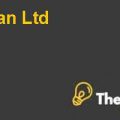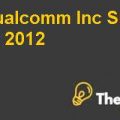INTRODUCTION
BCE is located in Canada and is the leading company in the telecommunication industry. Recently, it is facingfew challenges due to the market conditions which were changing rapidly. The demand of wire lineis reducing and it is the core business of the BCE. Another challenge that is faced by the BCE is the emergence of the wireless telephony that is growing rapidly and BCE is unable to capture the large portion of market share. On the other hand, its competitors such as Rogers Communications have competitive edge in wireless space.
The stock price of BCE is constant and in past seven years growth has been recorded at around 10% but it is lower than the S&P/TSX index and this growth has been recoded as 56.7%. BCE’s management has decided to adopt the strategy of separating its non-core business operations so that company can focus on the highly growth segment. The decision isperceived to be less valuable for the company by the analysts and financial market experts.
In the year 2007, BCE became the target company for the equity investors to acquire and market giants were attracted towards the BCE as an acquisition target. The reasons behind being an acquisition target is company’s cash flows, lower multiples, and moderate leverage. The stock price of BCE was $30.13 and this price was recorded on the 28th march 2007 and after few months, three private equity companies moved in to acquire the BCE. There is a rumor about the competitive company named Telus that, Telus is also seeking a way out to acquire BCE.
For the telecommunication industry there is an act regarding the industry that restricts the foreign companies to acquire Canadian firm and this act also encourages the competition in the industry. For these companies, it isdifficult to acquire BCE while the act isprevailing in Canada. Furthermore, there is aconcern about the price to acquire BCE Inc., and what amount should be paid as anacquisition premium and investors arealso concerned about the return on their investment.
CHALLENGES
There are following challenges which are faced by investors while identifying the price to pay as a premium to acquire BCE Inc., such as:
What valuation approach and assumptions should be used to calculate the per share price.To calculate the per share price in different valuation approaches there are various assumptions used and these assumptions have beenused to analyze the value of the BCE Inc. as well.
ANALYSIS
To analyze the value of BCE Inc. following assumptions were made such as:
v If using discounted cash flow approach than calculation also includes discount rate calculation, terminal value calculation, and net per share value.
v Discounted Cash Flow’s must be calculated using the 4% growth.
v What are the benefit of Leverage Buyout for BCE Inc.?
To calculate BCE’s value there arevaluation approachessuch as:
v Discounted Cash Flow
v Precedent Transaction Multiples
v Comparable Valuation approach
All of above mentioned valuation approaches used are analyzed below:
To calculate the value of BCE Inc. cash flow projection are used for the upcoming year starting from 2008 to 2012. The projection are developed considering the fact that BCE would be purchased by the investors at least for 5 years and the acquisition deal would be closed till the end of the year 2007. Considering the fact Telus is the only strategic buyer of BCE Inc. and it has to consider benefits out of this merger. To calculate the value of BCE various assumptions are taken into consideration such as:
Some of BCE’s non-core assets must be sold before the end of the 2007 and these non-core assets includeTelesat, BellAlliant, and CTV those are realized around $6.7 billion. After selling all of BCE’snon-core assets, the enterprise value would be financed by the mixture of debt and equity. Furthermore assumptionsare used in the calculation of discounted cash flows and these are given below:
From 2008 to 2012 revenue would grow by 2.4%, 2.3%, 1.8%, 1.9%, and 1.9% respectively. The earnings before interest taxes depreciation and amortization would be around 38.6% of the respective year’s sales. Depreciation would be around 17% of sales and it would remain the same in terms of percentage of that year’s sale. The tax rate is estimated to be 15% for the first three year and it is because of the tax losses that would be carried forward then it would increase from 15% to 25% and remain for the same for remaining two years.The Expected capital expenditure would be around $2,646 million for the year 2008, $2,707 million for the year 2009, $2,755 million for the year 2010, $2,808 million for the year 2011 and $2,862 million for the year 2012.
BCE’s long term debt ratio is 40% that is already targeted and its equity would be around 60%. The cost of borrowing would be around 8%....................
This is just a sample partial case solution. Please place the order on the website to order your own originally done case solution.
BCE Inc Facing the Future Case Solution
BCE Inc (BCE), one of Canada's leading integrated telecommunications companies are faced with numerous challenges. In the key wireless market, BC competition was back on the growth and income. BC's share price was ineffective and shareholders, including the powerful teachers' pension plan Ontario, became concerned. In addition, regulatory changes on the horizon that could have a major impact on the wireless unit of BCE a. CEO of AD in (CEO) was faced with the task of improving the competitiveness of our era, and shareholder value in a dynamic industry. What options did the CEO and his management team have, which ones would be better BC and how best to be met in order to satisfy shareholders in BCE? The case provides a good opportunity to assess the financial performance and help in understanding the interaction of strategy and finance. "Hide
by Stephen R. Foerster, W. Glenn Rowe, Heather Tobin Source: Richard Ivey School of Business Foundation 25 pages. Publication Date: July 29, 2009. Prod. #: 909N15-PDF-ENG












